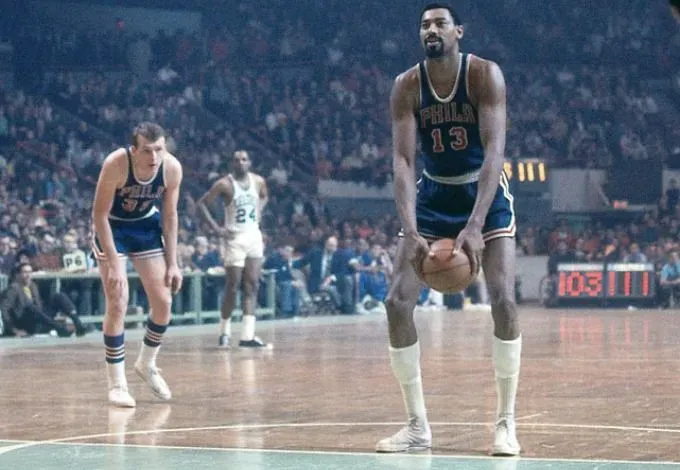Free Throws & Thresholds

By Lucas Pulley, Executive Director | Underground Network
In March of 1962, one of the most historic games of basketball was ever played, when Wilt Chamberlain scored 100 points in a single game against the Knicks. One of the most surprising aspects of his performance was shooting 28 out of 30 from the free throw line. Over the previous several years of his career, Chamberlain was a below average free throw shooter, typically in the 40% range. How does a 40% free throw shooter suddenly go 28 out of 30?
Because midway through his career, Chamberlain made a big change: he started shooting his free throws underhand (often known as the “granny shot”), and his free throw percentage doubled.
This change, and its shocking effect, was actually no surprise at all to Rick Berry. Rick is arguably the best free throw shooter of all time, and throughout his historic career, he was the only one in the NBA who shot his free throws underhand. Rick’s son was one of the best free throw shooters in the history of college basketball, and how did he shoot? You guessed it, granny style.
Shaquile O’Neal could have been the best to ever play the game if it weren’t for one fatal flaw, his free throws. He was so bad at free throws that other opponents started intentionally fouling him every time his team had the ball, a strategy now known around the NBA as “Hack-a-Shaq”. Behind closed doors, Rick Berry actually helped coach Shaq on underhanded free throws, and his percentages significantly improved. But he never shot underhand in a real game. Why?
Because it looks dumb. It’s embarrassing.
According to Rick Berry, and even sports scientists and physiologists, underhand free throws obviously produce better results because the underhand form simply makes more sense for the human body to produce a memorable, replicable, and concise motion. It’s easier to control, memorize, and repeat. If you survey professional NBA players, most of them actually agree with this, but none of them will actually do it. Why would professional NBA players refuse to adopt a simple skill set that they unanimously agree would increase their performance, stats, and win percentages?
Because it looks dumb. It’s embarrassing.
This is a classic demonstration of what sociologist Mark Granovetter calls “the threshold model of collective behavior”. He was exploring why people occasionally do things out of character, a question which was typically answered with a change in someone’s internal belief system. On his Revisionist History podcast, Malcolm Gladwell does a good job summarizing Granovetter's theory: “What does Granovetter mean by that word “threshold”? A belief is an internal thing, it’s a position we’ve taken in our head or in our heart. But unlike beliefs, thresholds are external, they’re about peer pressure. Your threshold is the number of people who have to do something before you join in. Granovetter makes two crucial arguments. The first is that thresholds and beliefs sometimes overlap, but a lot of the time, they don’t…Granovetter’s second point is just as important. Everyone’s threshold is different.”
Rick Berry and Wilt Chamberlain were great, in part, because they had a uniquely low behavioral threshold (a.k.a. they simply didn’t care what people think, and needed no peer momentum to allow them to shoot underhand). This low of a behavioral threshold is extremely abnormal for human beings. On the flip side, the vast majority of the NBA is willfully worse than they could be, because (1) they exist in culture that believes granny shots look dumb and (2) they have a higher (more normal) behavioral threshold.
You and I should immediately be wondering, “what behaviors have I embraced, or refused, not based on my beliefs but based on my threshold and the culture around me?”
Enormous amounts of data suggest:
- The isolation of individualism can have harmful effects, and yet we still isolate instead of connect.
- The bottomless pit of consumerism can starve our contentment further, and yet we still consume instead of participate.
- The coffin of selfish hoarding can increase our fears of scarcity, and yet we still refuse to be generous and sacrificial.
We often know what’s best for us, and a generally better way to be human, and yet we fail to act on our inner beliefs or convictions, because we might look dumb, or stand out, or simply can’t stomach the risk of a new behavior without a little social proof around us to get us to our own unique threshold.
I’m not sure the answer is for every individual to “work on themselves” and somehow change or develop their own behavioral threshold. I’m not sure Shaq needed to strive and exert his will to overcome his internal & external barriers. You know what Shaq needed? Shaq needed the entire Lakers team to look each other in the eyes and commit to the very pedestrian granny shot together.
Let’s cultivate communities and cultures that normalize the behavior that leads to human flourishing, rather than operating in a way that only the lowest thresholds, the Rick Berrys and Wilt Chamberlains of the world, get the goods. Let’s create communities that “look dumb” together in pursuit of a #WellBuiltCity, one granny shot at a time.
Until next time, be pedestrian.
